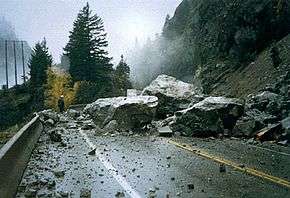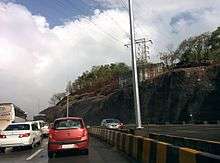Rockfall
A rockfall or rock-fall[1] refers to quantities of rock falling freely from a cliff face. The term is also used for collapse of rock from roof or walls of mine or quarry workings. "A rockfall is a fragment of rock (a block) detached by sliding, toppling, or falling, that falls along a vertical or sub-vertical cliff, proceeds down slope by bouncing and flying along ballistic trajectories or by rolling on talus or debris slopes."[2]

Alternatively, a "rockfall is the natural downward motion of a detached block or series of blocks with a small volume involving free falling, bouncing, rolling, and sliding". The mode of failure differs from that of a rockslide.[1]
Causal mechanisms
Favourable geology and climate are the principal causal mechanisms of rockfall, factors that include intact condition of the rock mass, discontinuities within the rockmass, weathering susceptibility, ground and surface water, freeze-thaw, root-wedging, and external stresses. A tree may be blown by the wind, and this causes a pressure at the root level and this loosens rocks and can trigger a fall. The pieces of rock collect at the bottom creating a talus or scree. Rocks falling from the cliff may dislodge other rocks and serve to create another mass wasting process, for example an avalanche.
A cliff that has favorable geology to a rockfall may be said to be incompetent. One that is not favorable to a rockfall, which is better consolidated, may be said to be competent.[3]
In high mountains rockfalls may be caused by thawing of rock masses with permafrost.[4] Yet in lower mountains with warmer climates rockfalls may be caused by weathering being enhanced by non-freezing condition.[4]
Mitigation

Typically, rockfall events are mitigated in one of two ways: either by passive mitigation or active mitigation. Passive mitigation is where only the effects of the rockfall event are mitigated and are generally employed in the deposition or run-out zones, such as through the use of drape nets, rockfall catchment fences, diversion dams, etc. The rockfall still takes place but an attempt is made to control the outcome. In contrast, active mitigation is carried out in the initiation zone and prevents the rockfall event from ever occurring. Some examples of these measures are rock bolting, slope retention systems, shotcrete, etc. Other active measures might be by changing the geographic or climatic characteristics in the initiation zone, e.g. altering slope geometry, dewatering the slope, revegetation, etc.
Design guides of passive measures have been proposed by Ritchie (1963),[5] Pierson et al. (2001),[6] Pantelidis (2010)[7] and Bar et al. (2016)[8]
Effects on trees
The effect of rockfalls on trees can be seen in several ways. The tree roots may rotate, via the rotational energy of the rockfall. The tree may move via the application of translational energy. And lastly deformation may occur, either elastic or plastic. Dendrochronology can reveal a past impact, with missing tree rings, as the tree rings grow around and close over a gap; the callus tissue can be seen microscopically. A macroscopic section can be used for dating of avalanche and rockfall events.
See also
- Earthquake
- Kinetic energy
- Landslide
- Potential energy
- Protection forest
- Q-slope
- Rockslide
- Slope stability
- SMR classification
References
- Whittow, John (1984). Dictionary of Physical Geography. London: Penguin, 1984. ISBN 0-14-051094-X.
- Varnes, D.J., 1978, Chapter 2, Slope Movement Types and Processes
- google.at, U.S. Geological Survey Professional Paper, Issue 1606 Debris Flows from Failures of Neoglacial-Age Moraine Dams in the Three Sisters and Mount Jefferson Wilderness Areas, Oregon Eisbacher & Clague, 1984, p.48
- Temme, Arnaud J. A. M. (2015). "Using Climber's Guidebooks to Assess Rock Fall Patterns Over Large Spatial and Decadal Temporal Scales: An Example from the Swiss Alps". Geografiska Annaler: Series A, Physical Geography. 97 (4): 793–807. doi:10.1111/geoa.12116. ISSN 1468-0459.
- Ritchie, A.M. (1963). Evaluation of rockfall and its control. Highway Research Record, No. 17, pp. 13-28.
- Pierson, L.A., Gullixson C.F., Chassie R.G. (2001) Rockfall Area Design Guide. Final Report SPR-3(032), Oregon Department of Transportation and Federal Highway Administration, FHWA-OR-RD-02-04.
- Pantelidis, L. (2010). Rock catchment area design charts. In Proceedings of GeoFlorida 2010 (ASCE) Conference on Advances in Analysis, Modelling and Design (pp. 224-233). doi:10.1061/41095(365)19
- Bar, N., Nicoll, S., Pothitos, F. (2016) Rock fall trajectory field testing, model simulations and considerations for steep slope design in hard rock, In PM Dight (ed), Proc. of First Asia Pacific Slope Stability in Mining Conference, Brisbane 6–8 September 2016, Australian Centre of Geomechanics, Perth, ISBN 978-0-9924810-5-6, pp.457-466.
External links
| Wikimedia Commons has media related to Rockfalls. |